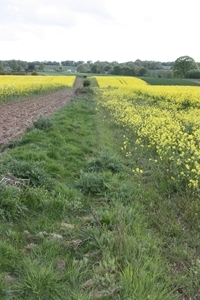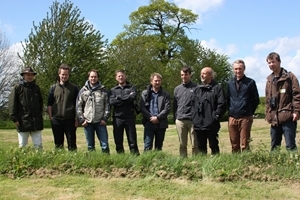 According to a comprehensive new report(1) on Europe’s wildlife and natural habitats, one in three European birds are now endangered, with once common species such as turtle doves, corn bunting and grey partridge plunging to an all-time low.
According to a comprehensive new report(1) on Europe’s wildlife and natural habitats, one in three European birds are now endangered, with once common species such as turtle doves, corn bunting and grey partridge plunging to an all-time low.
Mostly these declines are blamed on agricultural intensification fuelled by an increasing demand to feed a growing population.
However, an innovative cross-border project led by British wildlife researchers from the Hampshire-based Game & Wildlife Conservation Trust (GWCT), aims to help restore biodiversity on a European-wide scale by harnessing the results of 40 years of research on one of our most iconic species – the wild grey partridge.
Called ‘Grey Matters’, the project is being led by Dr Francis Buner, a research ecologist with the Game & Wildlife Conservation Trust, who has joined forces with more than 20 wildlife organisations across the UK, Belgium, Netherlands and France in an effort to help reverse the serious decline of key indicator species across the channel.
 Dr Buner explains, “We are using our successful research on grey partridges as the blueprint for farmland wildlife recovery. Our work on restoring grey partridge in the UK, which includes the development of novel wildlife-friendly habitats as well as other innovative techniques, has shown such dramatic results in the UK that many European conservation experts wish to use our model as a way of improving biodiversity in their own countries. This is a really exciting project and it is picking up on the concept of landscape scale conservation being used in the UK but across a massive land mass.”
Dr Buner explains, “We are using our successful research on grey partridges as the blueprint for farmland wildlife recovery. Our work on restoring grey partridge in the UK, which includes the development of novel wildlife-friendly habitats as well as other innovative techniques, has shown such dramatic results in the UK that many European conservation experts wish to use our model as a way of improving biodiversity in their own countries. This is a really exciting project and it is picking up on the concept of landscape scale conservation being used in the UK but across a massive land mass.”
Across Europe, farmland biodiversity is under severe pressure with many species undergoing declines of over 80 per cent in the last 50 years.
Dr Buner Explains the significance of this to Europe’s farmland wildlife, he said, “It is widely acknowledged that the intensification of agriculture across these European borders and the removal of natural habitats has devastated some wildlife populations. Our long-standing research has been pivotal in not only restoring grey partridges but in turn has also triggered a recovery of many other farmland birds as well as countless other wildlife species such as harvest mice and brown hares. The results have therefore attracted interest from other European Partners such as Bird Life (Netherlands), as well as other organisations that represent policy, research, conservation and farmland advice.”
This collaborative venture has five key elements to help reverse the decline of lowland farmland biodiversity across these EU countries, including setting up demonstration sites in each country to show the art of the possible to EU farmers. However, the main driver is to demonstrate that partridge-friendly farming in a modern agricultural context does increase the breeding density of a suite of key farmland birds together with other farmland biodiversity in general.
Frank Stubble from VLM (the equivalent of Natural England in Belgium), explained how he was impressed by UK agri-environment schemes. He said, “I think the UK is probably the most advanced country in the EU for the amount of money it pays its famers to implement conservation measures and is certainly ahead of Belgium. We pay about 30 million Euros to our farmers through our Rural Development programme but our birds are still declining. We need to encourage more biodiversity but our agricultural industry is very intensive because we are small and have to compete with world markets. However, it is vital that we improve our natural environments and we see this collaboration with the GWCT’s research on grey partridge as a way of helping us to achieve our ambition which is to learn and innovate while not detracting away from production.”
Members of the ‘Grey Matters’ partnership recently visited the UK to see the GWCT’s grey partridge recovery project in action at Rotherfield Park(2) in East Hampshire. Dr Buner says, “As the recent EU State of Nature report highlights, Europe’s wildlife and natural habitats are in crisis and the blame is being directed at unsustainable farming and land use policies. However, as our grey partridge project shows we know what to do to reverse this terrible downward trend and we have the right tools to do the job without compromising agricultural production. We now need commitment from policy makers to implement this blueprint across a much wider area. There is a will for change and we must make sustainable agriculture across Europe the goal.”
The 'Grey Matters' project is currently applying for funding through the EU.
END
Photocaptions: (1) An excellent example of an autumn cultivated uncropped margin, which features charlock and provides a perfect insect-rich foraging habitat for grey partridges and their chicks.
(2) Dr Francis Buner, from the GWCT (second left) at the GWCT’s grey partridge demonstration project at Rotherfield Park in Hampshire, with the EU representatives from Netherlands, Belgium and France who form part of the collaborative ‘Grey Matters’ project which aims to help reverse the decline of lowland farmland biodiversity across these EU countries.
Notes to editors:
1) The GWCT’s Rotherfield Park grey partridge demonstration project: The project is on a 3,600 acre estate in Hampshire and was launched in 2010 with the ambitious aim of re-establishing wild grey partridges where they had become extinct. Five years into the project grey partridges have made a remarkable comeback with autumn stocks increasing from zero in 2004 to a minimum of 108 birds in 2014. Additionally the GWCT aimed to show whether implementing all the management actions needed to restore grey partridges benefited other species of wild game and wildlife. Monitoring has shown that the project is now home to a remarkable number of breeding and wintering woodcock, a small but increasing number of breeding lapwings with above average fledging success, a growing number of breeding barn owls and kestrels, increasing numbers of farmland songbirds such as yellowhammers, skylarks, linnets and house sparrows, an impressive diversity of butterfly species because of the wide range of diverse habitats and a surprisingly high abundance of harvest mice.
Habitat and management activities implemented during the life of the project include : 1. Habitat restoration based on a Higher Level Stewardship (HLS) agreement - in particular the amount and quality of nesting cover, foraging cover and winter and escape cover; 2. Seasonal predator management - in particular wild bird keepering focused between April and July, together with winter feeding.
2) The EU State of Nature report: Every six years, Member States report on the conservation status of species and habitat types protected under the EU Directives. The report covers all wild bird species (about 240), 231 habitat types and more than 1200 other species of EU interest. This ‘State of Nature in the EU’ report is supported by a more detailed technical report prepared by the European Environment Agency, which also includes country-specific data. The reports serve as input to the coming Mid-Term Review of the EU Biodiversity Strategy. The findings of the report will also feed into the ongoing Fitness Check of the Birds and Habitats, which is part of a broader exercise of taking stock of EU legislation to ensure that it is fit for purpose. For more information: State of Nature in the EU – Commission report: http://ec.europa.eu/environment/nature/index_en.htm
3) The Game & Wildlife Conservation Trust (GWCT) – providing research-led conservation for a thriving countryside. The GWCT is an independent wildlife conservation charity which has carried out scientific research into Britain’s game and wildlife since the 1930s. We advise farmers and landowners on improving wildlife habitats and we lobby for agricultural and conservation policies based on science. We employ 22 post-doctoral scientists and 50 other research staff with expertise in areas such as birds, insects, mammals, farming, fish and statistics. We undertake our own research as well as projects funded by contract and grant-aid from Government and private bodies. The Trust is also responsible for a number of Government Biodiversity Action Plan species and is lead partner for grey partridge and joint lead partner for brown hare and black grouse. For Information, contact: Morag Walker – Head of Media, Telephone – direct-dial: 01425-651000. Mobile – 07736-124097 www.gwct.org.uk